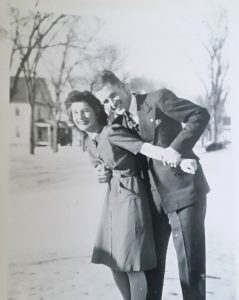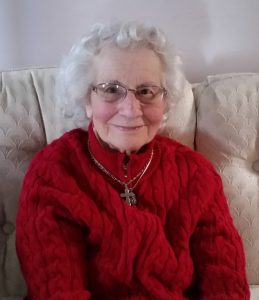Marion Roethle Roster: One tap or two?
Marion Roethle graduated from High School in 1943 in New Richmond, Wisconsin. She was the 6th of 8 children who were raised on a nearby farm. When her sister, Evelyn, and brother-in-law came home for her graduation he said jobs were available at the Glenn L Martin factory in Bellview, NE where he was a foreman. She moved there right away.
Initially Marion worked at a “fast food joint” where she encountered segregation firsthand. When a member of a band from a nearby club came to the restaurant for a meal, it was presented to him in a bag. The man said: “I wanted to sit down and eat this” but was told, “We don’t serve colored’s here”.
After 2-3 months, Glenn L Martin put out a call for more workers. Marion was hired as a riveter and she remembers learning to rivet and to read blueprints, though she didn’t specifically need the blueprint skill for her job. She worked as both riveter and bucker. Marion chose to work second shift as it paid a little better – $.99/hr. She worked 6 days a week “if my memory serves me correctly” yet still managed to ride the trolley car to church on Sundays.
Marion worked on the B26 tail/rudder. As a bucker, her job was to line up the bucking tool with the hole to be riveted and hold it until the rivet was driven in. She would then check to see if it was secure. If okay, she’d give two taps with the bucking tool. If it needed more, she tapped once. Then the riveter would punch it again. If you held the bucking bar crooked the rivet would have to be drilled out and a new rivet would have to be driven in. If the hole got too big it would have to be patched. “Most of the time the rivets were fine but sometimes they needed more work.”
When the plant stopped making B26’s and moved to the larger B29’s Marion was no longer able to be a riveter/bucker. “At 5’ ½”, I was too small to drive the large rivets needed for this plane”. The rivets were not only larger, they were ‘ice-box’ rivets that were kept on dry ice so they would be tighter when driven. At this point, she became a “runner”.
Working the second shift posed some problems, one of which was that most established businesses were closed by midnight. So Marion and her friends started the “big bomber club” and found private clubs to frequent after work. There they would listen to music, dance and have some fun giving their gas rations to those with cars. Marion remembers that she had several boyfriends at that time, but was not yet ready to commit.
Three of Marion’s brothers were in the service; one was based in Grand Island, near Omaha, another in the Pacific and the third in Italy. They all survived the war. Marion’s job, as others, ended on VJ day. She went into downtown Omaha to celebrate enjoying the dancing in the streets. Marion decided to wait a few months longer in Omaha for her brother, who had Malaria, to return from the Pacific. On the train home to Wisconsin, servicemen were being given preferential seating, but her brother wouldn’t board without her. He stepped back until they could board and ride together. Marion was asked if she was with him and she said “Yes”. At that point, both were both admitted onto the train, because they didn’t want to leave a serviceman behind.

After the war her first job was at the Continental Baking Company in Minnesota. It was a good job but only lasted through the Christmas rush. Her next job was soldering car radios. Then she started at the Bureau of Engraving where she worked until 1950. They had a softball team called the “Bureaucrats” – Marion played in the outfield. Charles Schultz of “Peanuts” cartoon fame, was their coach.
A few months after the war, Marion’s sister, Ida, was expecting a visit from her brother-in-law, who had just gotten out of the Navy. He wanted to meet Ida and his new nephew. She pleaded with Marion to stay home from work to help entertain him. Marion finally agreed and this was how her sister’s brother-in-law became Marion’s future husband.  The Big Bomber Club girl was finally ready to settle down, and 3 yrs later became Mrs. Robert Roster.
The Big Bomber Club girl was finally ready to settle down, and 3 yrs later became Mrs. Robert Roster.
They settled in Minnesota and had 5 children.
